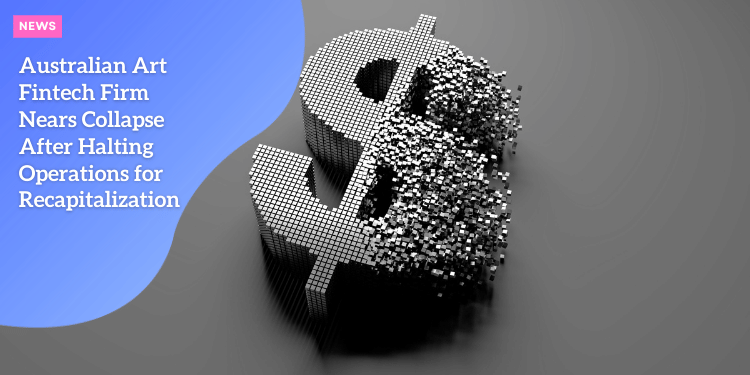Australian Art Fintech Firm Nears Collapse After Halting Operations for Recapitalization

Anúncios
The Australian art fintech company, Art Money, once a pioneering force in the digital finance sector for art transactions, has suspended its operations indefinitely, casting uncertainty on its future.
The company, which had its services utilized across more than 50 countries and secured a staggering $100 million in debt finance, is scrambling to secure the funds necessary for survival.
The Announcement and Immediate Fallout
This past weekend, Art Money communicated to its customers through an email ominously titled ‘The Hardest News’. The email detailed the company’s “difficult decision” to “pause business operations.”
Paul Becker, the Sydney-born founder and CEO of Art Money, disclosed that the fintech firm is actively seeking to “recapitalise” and requires an additional US$5 million (A$7.6 million) to pivot towards profitability.
“The business I founded, Art Money, has run out of operating capital and I’ve let down a lot of people who believed in it, and in me,” Becker admitted, underscoring the gravity of the situation.
Understanding Art Money’s Business Model
Launched a decade ago, Art Money operated in a manner similar to the buy now, pay later (BNPL) services that have proliferated in recent years.
However, it carved out a niche by targeting the art market specifically.
Customers could leverage the service to finance the purchase of artworks priced between $500 and $1 million, paying for their acquisitions in ten monthly installments without incurring any interest.
Like other BNPL companies, Art Money’s business model involved paying art sellers immediately, while recouping the funds from customers over time.
This structure necessitated significant upfront capital to keep operations running smoothly.
Economic Climate and Financial Struggles
The fintech firm’s financial challenges have been exacerbated by the broader economic downturn that has impacted numerous companies.
The quarterly figures and overall market conditions have created a challenging environment for startups and established firms alike.
In an interview with The Australian Financial Review last year, Becker had been optimistic about Art Money’s future.
He shared that the company had facilitated art sales worth US$56 million (A$83 million), with approximately 60% of those sales originating from Australia.
At its peak, Art Money had partnered with over 2,000 art galleries globally, facilitated over 20,000 art purchases, and attracted notable investors such as Christie’s, which invested $10 million.
Unfortunately, the current market conditions saw Art Money hit a critical juncture where it could not sustain its operational costs.
“Founders really only have three jobs,” Becker wrote candidly.
“Establish and convey the vision, assemble a strong team, and ensure sufficient financial resources.”After 10 years, I’ve fallen short on job #3.”
Immediate Consequences for Clients and the Art Market
The indefinite shutdown means that new clients are currently unable to apply for finance, and existing clients cannot make any further purchases through the platform.
This halt places a strain on both consumers who utilized the service for acquiring art and the artists and galleries who depended on it for timely payments.
Becker reassured that all galleries, artists, and sellers have either been compensated or will be shortly, in an effort to mitigate immediate negative impacts on the art community.
However, the comprehensive implications of this pause on the art market remain to be seen.
Broadening the Scope: Similar Cases and Industry Trends
The struggles of Art Money are not isolated. The BNPL sector, characterized by intense competition and heavy reliance on continuous funding, has seen several players encounter severe financial turbulence.
In February of this year, Australian ASX-listed BNPL service OpenPay became the first to collapse under the weight of substantial debt.
The company owed more than A$66.1 million to creditors and A$4.1 million in unpaid leave and wages to employees, leaving only A$1.2 million in liquid cash.
Similarly, Afterpay, another major player in the sector, reported a $345 million loss in 2022, attributing $176.7 million of those losses to bad debts.
On the other hand, Zip Co managed to cut its statutory net loss to $413 million for the fiscal year ending June 30, 2022, down from a staggering $1.1 billion the previous year, marking some improvement in its financial health.
Implications for the BNPL Industry and Startups
These examples underscore the precarious nature of BNPL companies, particularly as they navigate the fine line between aggressive growth strategies and sustainable business operations.
Startups and early-stage companies often rely heavily on investor funds to bridge the gap to profitability, much like Uber and Amazon did in their formative years.
Art Money’s struggles highlight the inherent risks associated with this business model, especially in a volatile economic climate.
The need for continuous capital infusion to cover operational costs, coupled with the pressure to achieve profitability, can create a delicate balance that is challenging to maintain.
Future Outlook and Potential Recovery
Despite the current challenges, Becker remains hopeful about the future of Art Money.
He suggested that with the necessary funds, the company is only about 18 months away from achieving profitability.
This insight offers a glimmer of hope for stakeholders, indicating that the company’s core business model may have the potential for success if navigated correctly.
The immediate focus for Becker and his team will be securing the required US$5 million to restart operations and push towards profitability.
If successful, Art Money could potentially reclaim its position as a significant player in the art finance sector.
In the broader context, the experiences of Art Money and other BNPL firms may prompt a reevaluation of business strategies within the sector.
Companies might adapt by pursuing more sustainable growth trajectories and implementing robust financial management practices to navigate economic uncertainties.
Conclusion
The halt in Art Money’s operations signals a significant moment for the company and the art finance industry at large.
While the decision to pause is a response to immediate financial constraints, it also offers an opportunity to reassess and strategize for a more stable future.
The coming months will be crucial as Art Money seeks to secure the necessary funds to resume operations and work towards profitability.
This situation serves as a reminder of the inherent challenges faced by fintech startups and the importance of maintaining a balance between growth and financial sustainability.
As the company navigates this turbulent period, the broader BNPL industry will likely observe closely, drawing lessons and potentially recalibrating their approaches to ensure long-term viability and success.
In summary, Art Money’s current predicament reflects broader industry trends and highlights the intricate dynamics of operating within the fintech and BNPL sectors.
The next steps taken by Becker and his team will be pivotal in determining the company’s future trajectory and its ability to emerge from this crisis stronger and more resilient.






